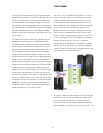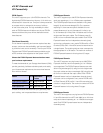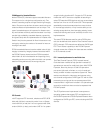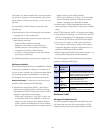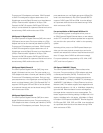SCSI IPL now a base function
The SCSI Initial Program Load (IPL) enablement feature,
fi rst introduced on z990 in October of 2003, is no longer
required. The function is now delivered as a part of the
server Licensed Internal Code. SCSI IPL allows an IPL of
an operating system from an FCP-attached SCSI disk.
FCP Full fabric connectivity
FCP full fabric support means that any number of (single
vendor) FCP directors/ switches can be placed between
the server and an FCP/SCSI device, thereby allowing
many “hops” through a Storage Area Network (SAN) for
I/O connectivity. FCP full fabric connectivity enables mul-
tiple FCP switches/directors on a fabric to share links and
therefore provides improved utilization of inter-site con-
nected resources and infrastructure.
FICON and FCP for connectivity to disk, tape, and printers
High Performance FICON – improvement in performance and
RAS
Enhancements have been made to the z/Architecture
and the FICON interface architecture to deliver optimiza-
tions for online transaction processing (OLTP) workloads.
When exploited by the FICON channel, the z/OS operating
system, and the control unit, High Performance FICON for
System z (zHPF) is designed to help reduce overhead and
improve performance.
Additionally, the changes to the architectures offer end-
to-end system enhancements to improve reliability, avail-
ability, and serviceability (RAS).
zHPF channel programs can be exploited by the OLTP I/O
workloads – DB2, VSAM, PDSE, and zFS – which transfer
small blocks of fi xed size data (4K blocks). zHPF imple-
mentation by the IBM System Storage DS8000
™
is exclu-
sively for I/Os that transfer less than a single track of data.
The maximum number of I/Os is designed to be improved
up to 100% for small data transfers that can exploit zHPF.
Realistic production workloads with a mix of data transfer
sizes can see up to 30 to 70% of FICON I/Os utilizing zHPF
resulting in up to a 10 to 30% savings in channel utiliza-
tion. Sequential I/Os transferring less than a single track
size (for example, 12x4k bytes/IO) may also benefi t.
The FICON Express4 and FICON Express2 features will
support both the existing FICON protocol and the zHPF
protocol concurrently in the server Licensed Internal Code.
High performance FICON is supported by z/OS for DB2,
VSAM, PDSE, and zFS applications. zHPF applies to all
FICON Express4 and FICON Express2 features (CHPID
type FC) and is exclusive to System z10. Exploitation is
required by the control unit.
IBM System Storage DS8000 Release 4.1 delivers new
capabilities to support High Performance FICON for
System z, which can improve FICON I/O throughput on a
DS8000 port by up to 100%. The DS8000 series Licensed
Machine Code (LMC) level 5.4.2xx.xx (bundle version
64.2.xx.xx), or later, is required.
Platform and name server registration in FICON channel
The FICON channel now provides the same information
to the fabric as is commonly provided by open systems,
registering with the name server in the attached FICON
directors. With this information, your storage area net-
work (SAN) can be more easily and effi ciently managed,
enhancing your ability to perform problem determination
and analysis.
Registration allows other nodes and/or SAN managers to
query the name server to determine what is connected
to the fabric, what protocols are supported (FICON, FCP)
and to gain information about the System z10 using the
attributes that are registered. The FICON channel is now
designed to perform registration with the fi bre channel’s
Management Service and Directory Service.
22




